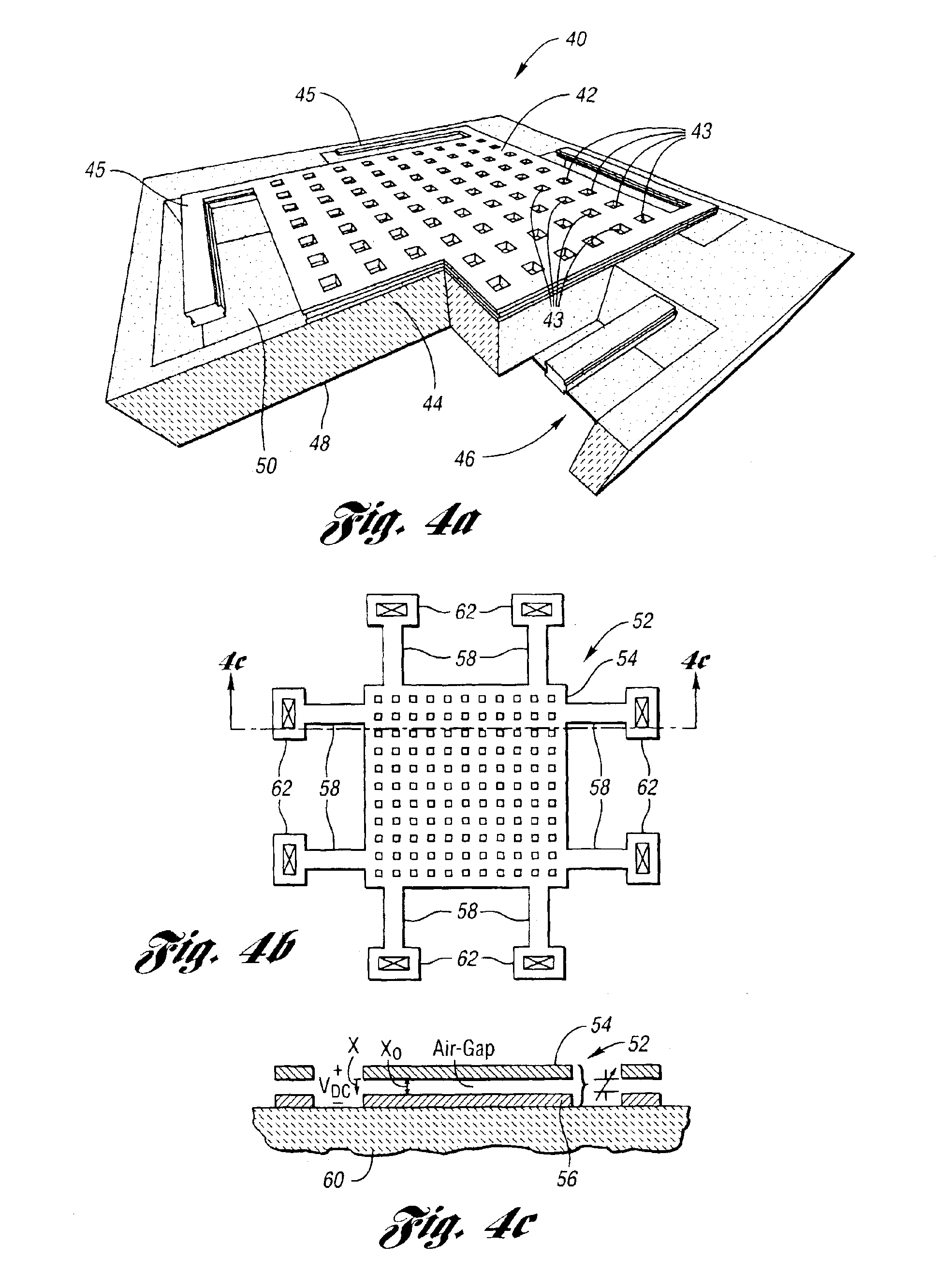MEMS-based, computer systems, clock generation and oscillator circuits and LC-tank apparatus for use therein
- Summary
- Abstract
- Description
- Claims
- Application Information
AI Technical Summary
Benefits of technology
Problems solved by technology
Method used
Image
Examples
first embodiment
[0136]Referring now to FIG. 4a, there is illustrated a varactor fabricated upon an SOI substrate, generally indicated at 40, which focuses on the most significant drawbacks associated with previous MEMS varactor work. First, the fabrication process is CMOS compatible in order to achieve monolithic integration. Second, the tuning range is sufficiently wide. Third, the quality factor (Q-factor) is high. The varactor 40 addresses all of these issues as follows.
[0137]First, the parallel plates 42 and 44 of the varactor 40 are fabricated as part of a standard CMOS process where either the metal-insulator-metal (MiM) layers or the appropriate metal routing layers are used. Support arms 45 support the top plate 42 above the bottom plate 44. These support arms 45 may be designed in one of a variety of geometries in order to suspend the top plate 42 appropriately. No additional processing steps are required to define the structure. However, a maskless post-process is used to release the plat...
second embodiment
[0141]Referring now to FIGS. 4b and 4c, there is illustrated a varactor fabricated in a bulk CMOS process, generally indicated at 52, of the present invention. The varactor 52 includes a movable top plate 54 and a stationary bottom plate 56. The top plate 54 is supported above the bottom plate 56 by a mechanical suspension network 58 which is anchored to a substrate 60 at anchors 62.
[0142]In particular, the micromechanical varactor 52 has a parallel plate topology similar to those presented in the prior art. The varactor 52 is constructed by mechanically suspending the metal top plate 54 in air above the fixed metal bottom plate 56. The mechanical suspension network 58 provides support for the top plate 54 as shown. The varactor 52 presents a nominal capacitance set by the varactor geometry and the nominal gap between the plates 54 and 56, xo. By applying a positive DC voltage, VDC, across the plates 54 and 56, the movable top plate 54 will deflect some distance, x, due to electrost...
third embodiment
[0170]FIG. 7c illustrates the present invention. Here the blocking capacitors of the embodiment of FIGS. 7a and 7b are not needed as the tuning voltage for the MEMS varactor (i.e. 52′) is applied to a common node that is isolated from the sustaining circuit by the MEMS varactor structures themselves. The oscillator includes an inductor 72′ and a common mode capacitor 87′. As indicated by the prime designation, the varactors 52′, the inductor 72′ and the capacitor 87′ have the same or similar structure as the varactors 52, the inductor 72 and the capacitor 87 of FIG. 7b.
[0171]The oscillator core of FIG. 8a generates a differential sinusoidal signal, which is tapped across the tank. In order to convert this signal into a clock, or square-wave digital signal, the differential signal is converted to a single-ended signal, as shown in FIG. 8a. This signal then clocks a D-flip-flop that has its complementary output tied back to the D input. From here, the clock can be divided arbitrarily...
PUM
 Login to View More
Login to View More Abstract
Description
Claims
Application Information
 Login to View More
Login to View More - R&D
- Intellectual Property
- Life Sciences
- Materials
- Tech Scout
- Unparalleled Data Quality
- Higher Quality Content
- 60% Fewer Hallucinations
Browse by: Latest US Patents, China's latest patents, Technical Efficacy Thesaurus, Application Domain, Technology Topic, Popular Technical Reports.
© 2025 PatSnap. All rights reserved.Legal|Privacy policy|Modern Slavery Act Transparency Statement|Sitemap|About US| Contact US: help@patsnap.com



